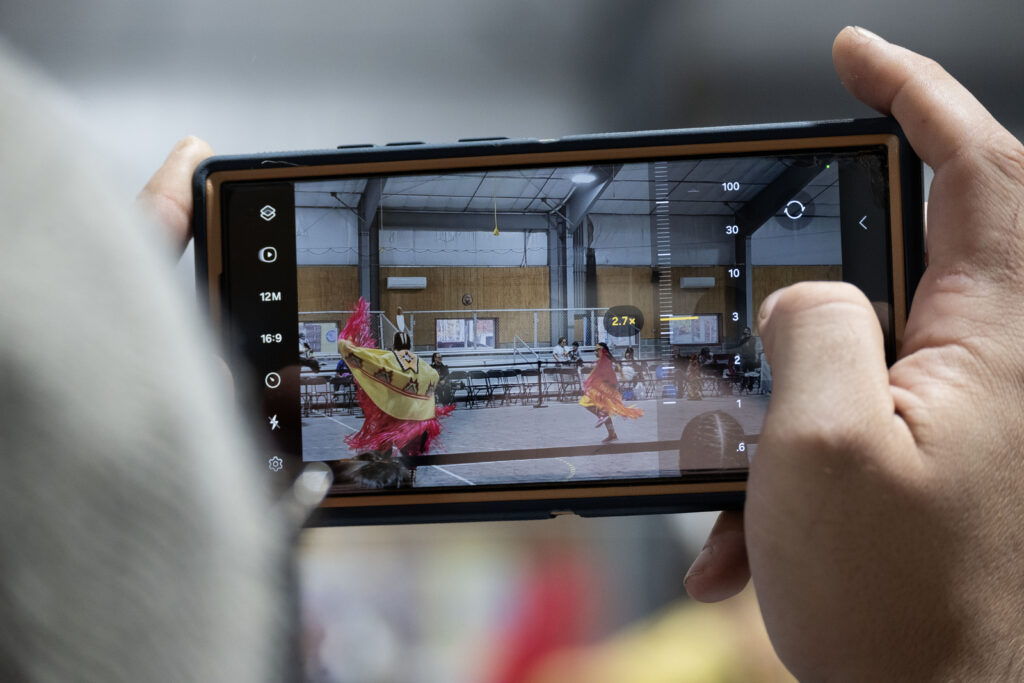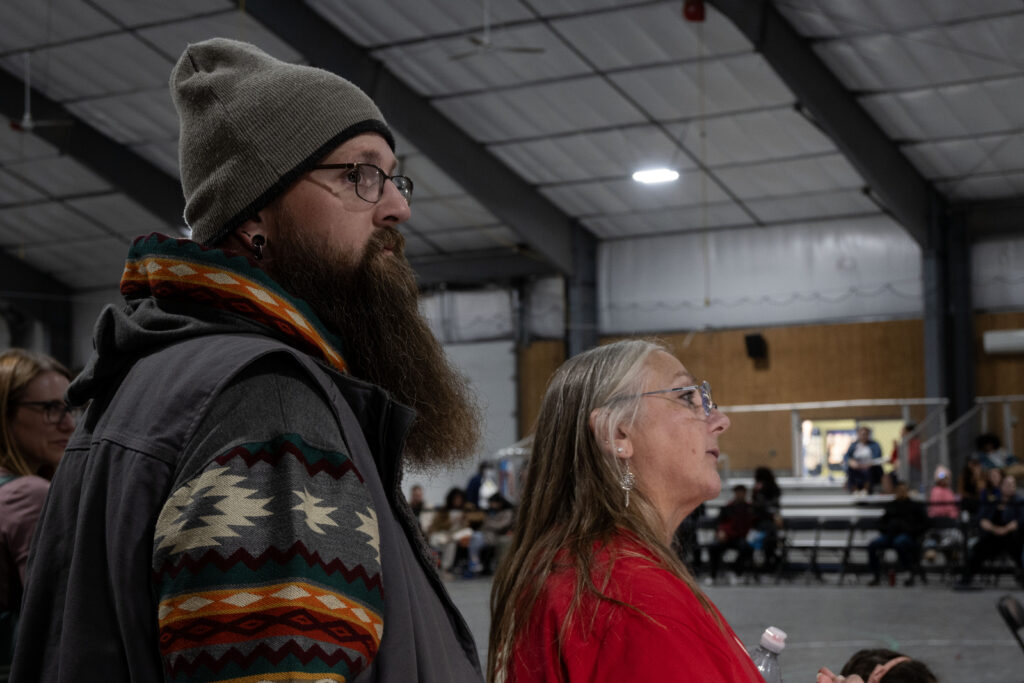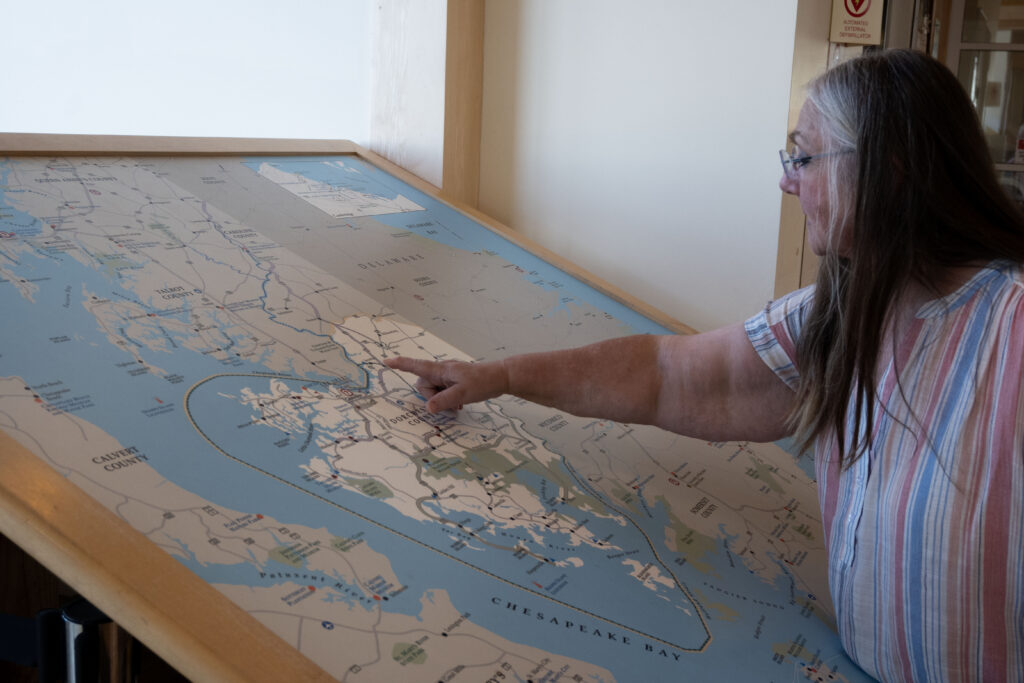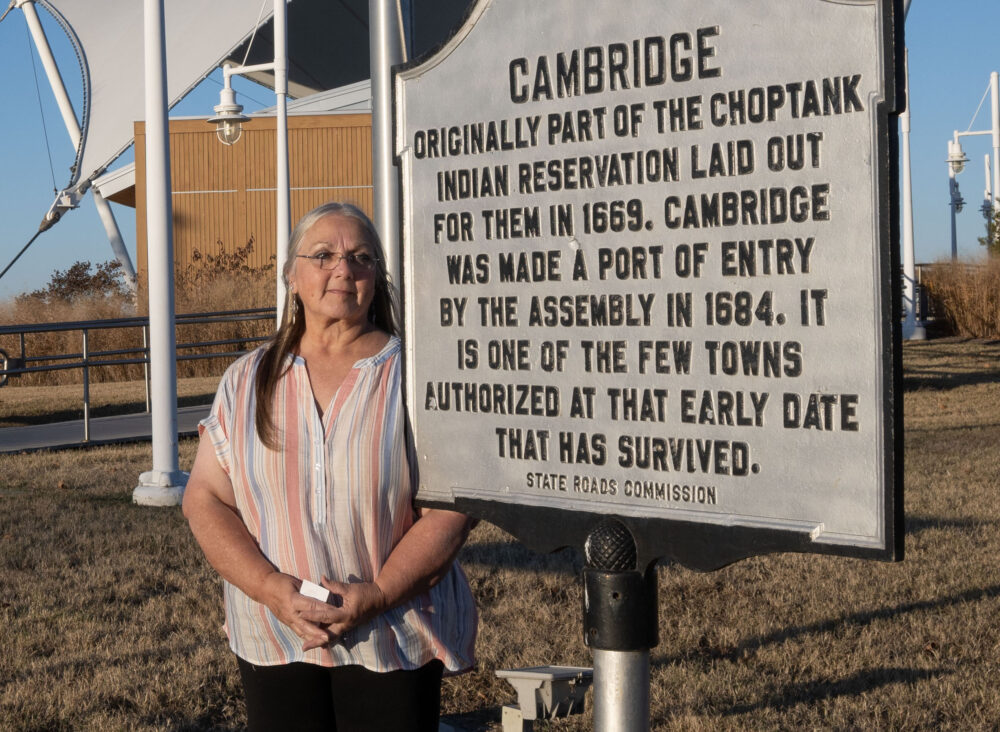CAMBRIDGE, Md. – A little over five feet tall, the chief of the Nause-Waiwash walked quickly. Despite a limp from a recent total knee replacement, she zipped up and down the stairs at the Dorchester County Visitor Center.
The chief beamed as the overhead lights caught in her silver dreamcatcher earrings and white-streaked hair. Her blue-gray eyes darted over the various exhibits displaying pieces of her culture and history: a photograph of her uncle fishing, a miniature Nause-Waiwash longhouse and a taxidermied white muskrat.
The Nause-Waiwash tribe is one of the seven Native American tribes that are represented on the Maryland Commission of Indian Affairs, although the tribe is not state-recognized. The tribe, whose origins and traditions were once nearly lost but now are being revitalized, does statewide educational outreach to, as their chief says, “tell their story in their own words.”
Chief Donna Wolf Mother Abbott is the first woman chief of a Maryland tribe in known recorded history.
Abbott has now been “Chief Donna” for 10 years. However, when she was first approached to run, she had serious doubts about whether she even wanted to become chief.
“But then I got thinking again, it’s not about me,” she said. “If I didn’t step up and take on the responsibility I felt like that, all that would have just disappeared, and again, we would have lost our history one more time.”
As chief, Abbott is in charge of planning the tribe’s annual festival, overseeing educational outreach and acting as a liaison between the tribe and conservancy groups.
Deborah Barber, director of land conservation at the Nature Conservancy’s Maryland chapter, has worked with Abbott on a handful of projects and said she admired Abbott’s willingness to work with others within and outside of the native community.
Barber said a conversation with Abbott made her realize that what she was doing with her own children, being intentional about the values she is instilling in them, Abbott is doing with her own family and the whole tribe.
“She’s doing it times 150,” Barber said in an interview with Capital News Service.
It wasn’t until Abbott was in her 30s and already a mother that she became fascinated with researching and passionate about preserving her culture.
“Growing up, I knew I was Native American, but it wasn’t something that we shouted from the rooftops,” she said. “It was just who we are.”

Abbott said it was her cousin who approached her and told her she needed to join the tribe, but when Abbott resisted, her cousin told her, “It’s not about you.”
“It’s about preserving what we have and learning and teaching and then teaching it for our next generation,” Abbott said.
Since then, she has been dedicated to learning about her culture and educating others.
“I myself, I want to learn it all,” she said. “Just not enough hours in the day.”
However, as she became more involved in the native community, she also encountered stereotyping from both native and non-native people because she passes for white.
“‘How much Indian are you?’ How much do you want me to be? How much do I have to be? Does it make a difference?” Abbott said. “Not just the Nause-Waiwash—but not all tribes are tall, thin, with black hair and high cheekbones, riding bareback.”
However, Abbott said that when she does encounter stereotyping or unfamiliarity with her culture, she turns to optimistic grace.
“I really try to blame it on the lack of knowledge,” she said. “I’m like, ‘These people don’t know any better, so let’s teach them.’ So, I try not to take it personal. But I go through the ‘okay, I’m mad now.’ … and then I get over it.”
Beyond tackling the prominent misconception that there were no more Indigenous people in the region, Abbott faced a multitude of challenges to increasing tribe membership. One of them is sexism from within and outside of the native community.
“…Here we are (in) 2024, and there’s still so much gender discrimination and thoughts out there about, ‘Oh, you have to be a warrior to be a chief,’ And I’m like, ‘Says who? No, you’re practicing Western history,’” Abbott said.
Abbott said that some had used her gender against her and shamed her for not being as firm as the previous chief.
“I have been told I’m a pushover. I am a people-pleaser. And ‘Who’s ever heard of a woman chief? Who’s ever heard of a chief or an Indian with blue eyes?’” she said.
Jerry “Gentle Bear” Hughes is 34 years old and serves as the Nause-Waiwash Band of Indians’ vice chair and social media administrator. He is also Abbott’s son, and he said it was his mother becoming chief that persuaded him to become involved with the tribe in his 20s.

Although Abbott’s leadership might be controversial to some, Hughes said it’s led the tribe to new opportunities.
“Oh, she’s been an inspiration to everyone involved,” Hughes said. “We’ve seen a lot of people who had stepped away because people had rubbed them the wrong way or made them angry or said something out of line. We’ve seen a lot of those people come back. We’ve had a lot of olive branches extended to us since she’s been elected.”
Prospective chiefs in the Nause-Waiwash tribe are nominated by the tribe’s council to run, and the tribe’s women vote for them. In 1988, the Nause-Waiwash Band of Indians was formed to preserve the Nause-Waiwash culture. A council of elders was created, and the tribe’s women elected Sewell Fitzhugh as the chief.
Twenty-six years later, Fitzhugh, known as Chief Winter Hawk, died, and in November 2014, Abbott was elected as his successor.
She has had doubts about making the right decisions for the tribe and questioned her own leadership.
“I have actually considered stepping down, and my son has said, ‘If you step down, then who’s gonna do it?’” she said. “But if I step down and nobody does it, then I feel I’m going to feel responsible for letting everything go and being a part of what caused us to lose our history again. And I don’t know that I would be happy with myself if I did that.”
The Nause-Waiwash people have always been in Dorchester County, which is known for its lush wetlands, diverse wildlife and crabbing and fishing on Maryland’s Eastern Shore. They are descendants of the Nanticoke and Choptank tribes of modern-day eastern Maryland and Delaware. Unlike other Native American tribes, the Nause-Waiwash escaped persecution and death by hiding in plain sight for centuries and sometimes marrying Europeans.

“When I was in school, there were three paragraphs about the Trail of Tears that didn’t apply to us,” Abbott said.
However, even within the Nause-Waiwash community and Abbott’s own family, people’s connections to their Indigenous heritage can be complicated.
“My own sister does not identify as Native American,” she said. “It just is not important to her. However, I do. Same mother, same father.”
When someone wants to join the tribe, Abbott and other members must do a lot of genealogical research to verify connections to the tribe.
One major challenge for the tribe is getting younger people more involved.
Another is that younger tribal members are moving away from the area because of rising sea levels.
“It is just my opinion, but in the next hundred years, the Eastern Shore is probably not even going to be here based on what I see on our trapping grounds,” she said. “That part of the county probably won’t be here in the next 50 years.”
Dorchester County is one of the regions in the country with the fastest sea-level rises, according to research by the Virginia Institute of Marine Science. In 2020, the National Oceanic and Atmospheric Administration released a study that said, for example, sea levels for the Chesapeake Bay increased twice that of the global average over the 20th century.
For Abbott, who said she feels she’s only scratched the surface of her people’s history on her ancestral lands, the environmental changes feel especially tragic.
“I think that’s going to be a part of our history that we’re going to lose, that we can’t get back because a lot of our ancestral land will be gone,” she said. “There are probably hundreds of cemeteries that have washed away. We are never to get those back.”
But Abbott stays optimistic about the future of her tribe.
“I think the culture can survive because the history in the culture, in their traditions, are the ones who practice it,” she said. “And I think if we all pull together, then yes, absolutely, it’ll survive whether we have our ancestral land or not.”


You must be logged in to post a comment.